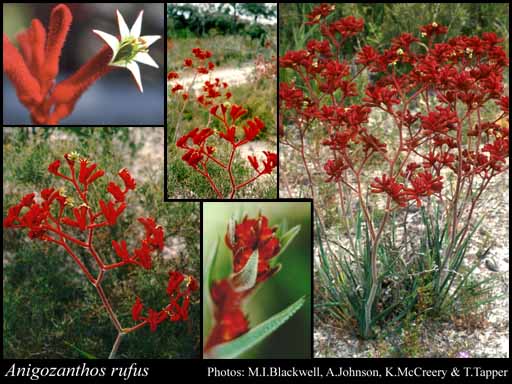- Reference
- Voy.Rech.Perouse 1:409 (1800)
- Conservation Code
- Not threatened
- Naturalised Status
- Native to Western Australia
- Name Status
- Current
Rhizomatous, perennial, herb, 0.2-1 m high. Fl. red-purple/yellow, Aug to Dec or Jan. White, grey or brown sand. Seasonally-wet areas.

Scientific Description
Leaves flat, 175-280 mm long, 4-7 mm wide; bristles or hairs on the leaf margin present, 0.5-1 mm long, with at least some small side branches at the base, straight and rigid, lying parallel with the margin or angled towards the leaf apex; hairs on the surface of the leaf present. Scape present, hairy, 400-460 mm long. Inflorescence subtended by a bract 15-30 mm long, with several flowers; floral bracts 6-10 mm long; pedicels present, 2.5-6 mm long; flowers 25-30 mm long. Perianth hairy, bilaterally symmetric, uniformly coloured, yellow or red, with six more or less equal tepals, the inner segments 7-8 mm long. Stamens six, in three levels, in pairs; filaments 3-4 mm long; anther 2.3 mm long, without an appendage. Style 17-25 mm long. Flowers in January, August, September, October, November or December. Occurs in the Coolgardie, Jarrah Forest, Mallee and Esperance IBRA bioregion(s), of the Eremaeam and South-west Botanical Province.
Distribution
- IBRA Regions
- Coolgardie, Esperance Plains, Jarrah Forest, Mallee.
- IBRA Subregions
- Eastern Mallee, Fitzgerald, Recherche, Southern Cross, Southern Jarrah Forest, Western Mallee.
- IMCRA Regions
- WA South Coast.
- Local Government Areas (LGAs)
- Albany, Cranbrook, Dundas, Esperance, Gnowangerup, Jerramungup, Kent, Lake Grace, Plantagenet, Ravensthorpe.